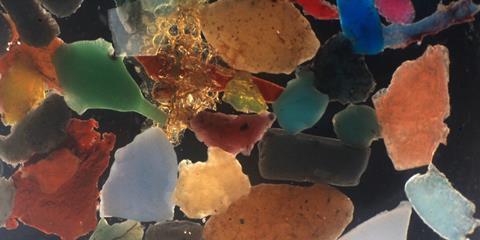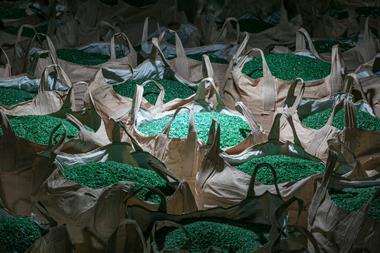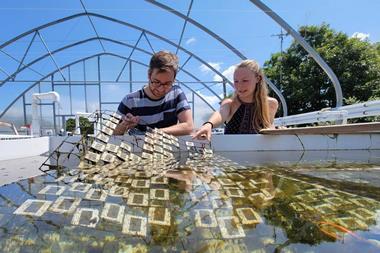A bacterium has been discovered that can digest plastic, and its discovery goes some way to explaining why there is significantly less plastic in the oceans than models predict.1
A team from the Royal Netherlands Institute for Sea Research started their investigation with a polyethylene plastic that contained carbon-13. When the bacterium Rhodococcus ruber was exposed to this plastic the carbon dioxide that was evolved contained carbon-13, meaning that the bacterium had metabolised the plastic.
The isotope was also found in the bacterium’s fatty acids, showing that it had not only metabolised the plastic, but also incorporated its breakdown products. The scientists calculated that R. ruber can break down about 1% of the available plastic in the oceans per year into carbon dioxide and other harmless substances. But the researchers acknowledge that this could be an underestimate as they only monitored the carbon-13 in the carbon dioxide produced, and not in other metabolites produced by the bacterium.
‘This is the first time we have proven in this way that bacteria actually digest plastic into CO2 and other molecules,’ said lead researcher Maaike Goudriaan. Previous studies have already demonstrated that R. ruber can form a biofilm on plastic in nature, and that plastic disappears under that biofilm.
While 1% might sound unimpressive, it can add up year after year. ‘You have to imagine such a plastic piece swimming in the ocean not just for one year, but maybe it was released in 1976 for example, and it would then every year lose a couple of percent of its mass – either to microbial degradation or to photooxidation,’ says Helge Niemann, a biogeochemist at the Royal Netherlands Institute for Sea Research.
Missing plastic mystery
Estimates of the amount of global plastic waste that wind up in the ocean each year range from 1.7% to 4.6%, meaning that around 117 to 320 million tonnes (Mt) of plastic has entered the world’s oceans between 1950 and 2015. However, research has found that only about 0.61–1.65Mt of plastic debris is floating in the oceans. This phenomenon, dubbed the ‘ocean plastic paradox’, suggests that marine plastic debris is somehow being eliminated.

‘We wanted to know if the ocean is in principle a trash bin where plastic is just going in and then it stays there forever, or whether there are processes that remove plastic in a natural way,’ Niemann states.
A separate study led by Annalisa Delre at the same Dutch institute, in collaboration with Goudriaan and Niemann, recently demonstrated that sunlight breaks down plastic on the ocean surface into smaller and smaller pieces that eventually become invisible to the naked eye and spread throughout the entire water column.2 The study calculated that about 2% of visibly floating plastic may disappear from the ocean surface in this way each year.
Just one part of the puzzle
While the mystery of the missing plastic isn’t solved, a clearer picture is emerging of what’s happening to this marine litter. ‘The bacteria are just one piece of the bigger puzzle,’ Goudriaan states. ‘We are a bit closer to the answer.’ She says the positive message is that if humans stop plastic entering the oceans then it will disappear eventually.
Collin Ward, a marine chemist at Woods Hole Oceanographic Institute in Massachusetts, US, who was not involved in the research, says this work adds to ‘a growing body of knowledge that sunlight exposure can initiate chemical reactions that make plastic more labile or tasty to microbes living in surface waters’. For many decades, he notes, this pathway has been known to be important in soil systems but now this and other research are demonstrating that the same process occurs in aquatic systems.

‘While this coupled sunlight and microbial degradation pathway certainly represents a loss term, or a sink, within the marine plastic budget, a lot more research is needed to quantify the extent in which it helps explain the “missing plastic” paradigm,’ Ward adds.
He suggests that one important implication of the research is that studying the fate or persistence of plastics in the absence of sunlight, which is often the case in past studies, may yield overestimates of its environmental persistence.
Andrew Tanentzap, a global change ecology researcher at the University of Cambridge, UK, says the estimates provided in this paper are small because they focus exclusively on the conversion of plastics into carbon dioxide. ‘A large amount of plastics is likely being converted into bacterial biomass and other dissolved molecules that were not measured, so the true amount of plastics degraded by the bacterium in this study was likely underestimated,’ he says.
Further, Tanentzap points out that this study only focuses on one bacterial species, and previous research he was involved in has yielded evidence that different bacteria may have complementary effects on the ability of bacteria to metabolise plastic-derived leachate.
References
1 M Goudriaan et al,Mar. Pollut. Bull., 2023, DOI: 10.1016/j.marpolbul.2022.114369
2 A Delre et al,Mar. Pollut. Bull., 2023, 10.1016/j.marpolbul.2022.114544

















No comments yet